ISSN ONLINE(2319-8753)PRINT(2347-6710)
ISSN ONLINE(2319-8753)PRINT(2347-6710)
Bojja.Devadanam1, M K MV Ratnam2 and Dr.U RangaRaju3
|
| Related article at Pubmed, Scholar Google |
Visit for more related articles at International Journal of Innovative Research in Science, Engineering and Technology
Earthquakes are one of the major natural calamities which have a potential to paralyse human life by causing disturbance to infrastructure and lifeline facilities. Water tanks are considered to be part of crucial services in many cities. Their safety and functionality is critical concern during strong earthquakes as they contribute for essential requirements viz. drinking water, quenching fires in case of fire accidents, etc. Hence, these structures should not collapse even after an eventual earthquake. The objectives to be achieved through this concept are Study of seismic resistant design of elevated water tanks as per IS CODE: 1893 and IITK-GSDMA guidelines, Finite element modelling and seismic analysis of Elevated water tanks using SAP2000, Study the influence of various parameters (Viz., Seismic intensity, soil conditions, etc) on the seismic behaviour of elevated water tank and Study the influence of staging height on the base shear and ductility characteristics of elevated water tank by performing non linear static analysis using SAP2000.
Keywords |
| seismic resistant design, SAP2000, ductility, IITK-GSDMA, Finite element modelling. |
INTRODUCTION |
| In the concept of avoiding earthquake effects on the water tanks. Hence, in view of this need, research activity has been primarily focused on understanding the seismic behaviour of ground and elevated water tanks. It has been observed since last decade that the supporting structures for elevated water tanks have suffered damage after strong earthquakes leading to collapse of certain elevated water tanks—Bhuj and Lattur post earthquake studies. Further, it can be observed that reinforced concrete elevated water tanks with frame staging, has shown better seismic resistance than reinforced concrete elevated water tanks with shaft staging. These can be attributed to the seismic energy absorption capacity of the frame staging. Hence this study is primarily focussed on understanding the seismic behaviour and performance characteristics of elevated water tank with frame type staging. Moreover, circular tanks have minimum surface area when compared to other shapes for a given capacity of the tank. Hence the quantity of material required for circular water tank is less than that required for other shapes. Hence, a circular water tank has been adopted in this study. |
LITERATURE SURVEY |
| 1. (Durgesh C Rai) [1] The performance of elevated water tanks in 7.7 magnitude Bhuj earthquake of January 26th, 2001 was studied. Many of the elevated water tanks which were collapsed during the Bhuj earthquake were studied and the reasons of their collapse were understood. |
| 2. (Hamzeh Shakib)[2] Choose a water tank problem and Finite element method was used to model the elevated tank, Columns and beams in the support system are modelled as frame elements. For different water conditions like empty, full and half-full case was studied and the time period, modal participation mass ratio were calculated. Base shear, overturning moment, roof displacement, sloshing displacement were studied. |
| 3. (MANISH N. GANDHI)[3] Explained about frame staging type Elevated water tanks, which consist of huge water mass at the top of a slender staging which are most critical consideration for the failure of the tank during earthquakes. Many of the water tanks which failed due to earthquake forces are shaft supported water tanks, which are needed to be avoided in seismic zones. It was also identified that, for higher seismic zones general frame staging is not sufficient special staging with bracings are required. |
| 4. (Soheil Soroushnia)[4] Different failure patterns were observed in the water tanks in the Bhuj area and the cause of it were identified. The different patterns of failures observed were Shear failure modes in beams, bendingshear failure in beams, axial failure in columns, cracks in connections & torsion failure. |
FAILURE INVESTIGATION |
SHEAR FAILURE MODES IN BEAMS |
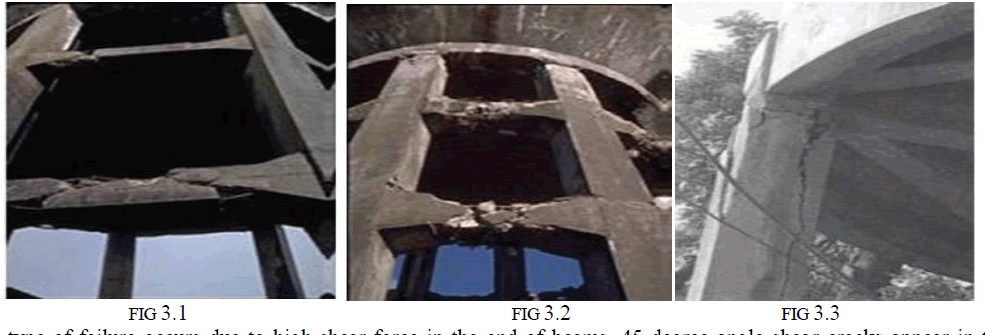 |
| This type of failure occurs due to high shear force in the end of beams, 45 degree angle shear cracks appear in the plastic joints. This type of failure is observed in Chile earthquake in South America in 1960 with a magnitude M=8.5, for aerial water reservoir. |
BENDING-SHEAR FAILURE IN BEAMS |
| This type of failure in the bending-shear cracks beams occurs in the middle section beams with a gradual increase in failure towards the centre of the beam. Shown in fig 3.2 |
AXIAL FAILURE IN COLUMNS |
| Another type of the failure to vertical cracks occurs due to forces column compressive is on them. An example of this type of failure is Bhuj earthquake in India in 2001 with a magnitude M=7.7, for the elevated water tank with 20 cubic meters capacity located in Gujarat near Anjar, built in. Deep cracks in the columns were observed. The cracks occurred along of longitudinal reinforced of column. Also, in the column connection to the container holder system were developed cracks vertically that low the performance of columns. It has suffered in elevated tank; however it has not been collapsed and the axial failure model is shown in fig 3.2 |
ANALYSIS OF ELEVATED WATER TANKS |
GENERAL DETAILING |
| Seismic analysis of elevated water tanks are carried out based on the guidelines given in IS1893-part2. In view of limitations of IS 1893:1984 in comparison with international practice for seismic design of elevated water tanks IITKGSDMA has proposed certain additional guidelines for seismic analysis and design of liquid storage tanks. The present study considers IS 1893 part1 provisions along with IITK-GSDMA guidelines for analysing the elevated water tanks. |
| Compared to provisions of IS 1893:1984, in IITK-GSDMA Guidelines following important provisions and changes have been incorporated |
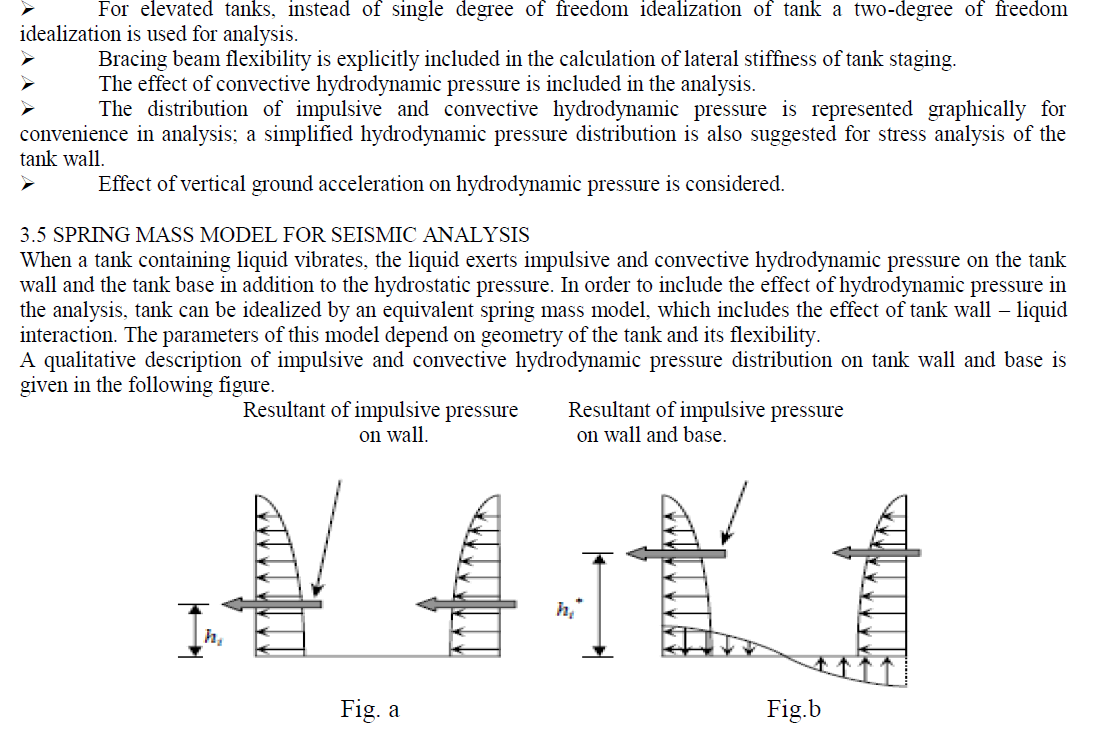 |
FINITE ELEMENT MODEL |
| The finite element model of the elevated water tank is done using SAP2000 software. SAP2000 offers a single user interface to perform: Modelling, Analysis, Design, and Reporting. |
MATERIAL PROPERTIES |
| The grade of concrete and grade of steel required for the analysis of water tank are defined in this section. Grade of concrete is taken as M20 and grade of rebar is taken as Fe415. |
SECTION PROPERTIES |
| The frame sections and the area sections are to be defined in this section and they have to be assigned with material properties defined in section 4.1. |
a. Frame sections. |
| All the frame sections viz. Braces, column & floor beam are defined in this section, the section properties assigned are shown in table 4.1. |
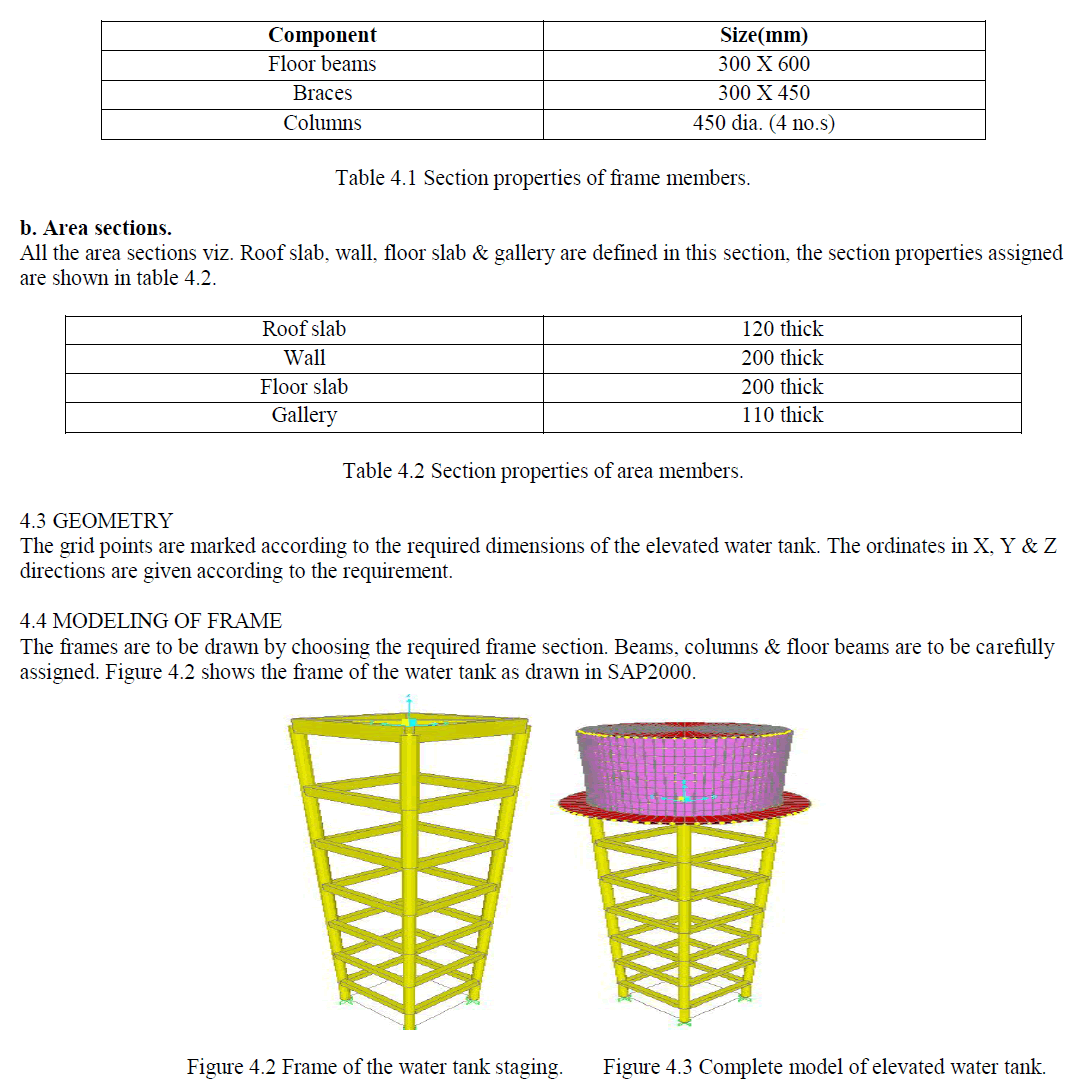 |
LOAD COMBINATIONS |
| The load combinations are to be defined as per IS 1893 (part 1): 2002. |
| The different combinations chosen are |
| 1.5(Dead load + Live load) |
| 1.2(Dead load + Live load + Earthquake force (EQX, EQY)) |
| 0.9Dead load + 1.5 + Earthquake force (EQX, EQY) |
| 1.5(Dead load + Earthquake force (EQX, EQY)) |
| These combinations are to be considered for X, Y and also at a 45 degrees angle to X axis so as to known the most critical combination. |
CASE STUDY |
INPUT DATA |
| In this study, a circular elevated RC water tank having diameter 5.65m, with four column staging has been considered as a Numerical problem for understanding the seismic behaviour under the influence of various parameters discussed in section 5.1. |
| The relevant properties required for analysis has been depicted below. |
| Circular water tank, diameter = 5.65m |
| Capacity of tank= 100m3 |
| Height of staging = 20m |
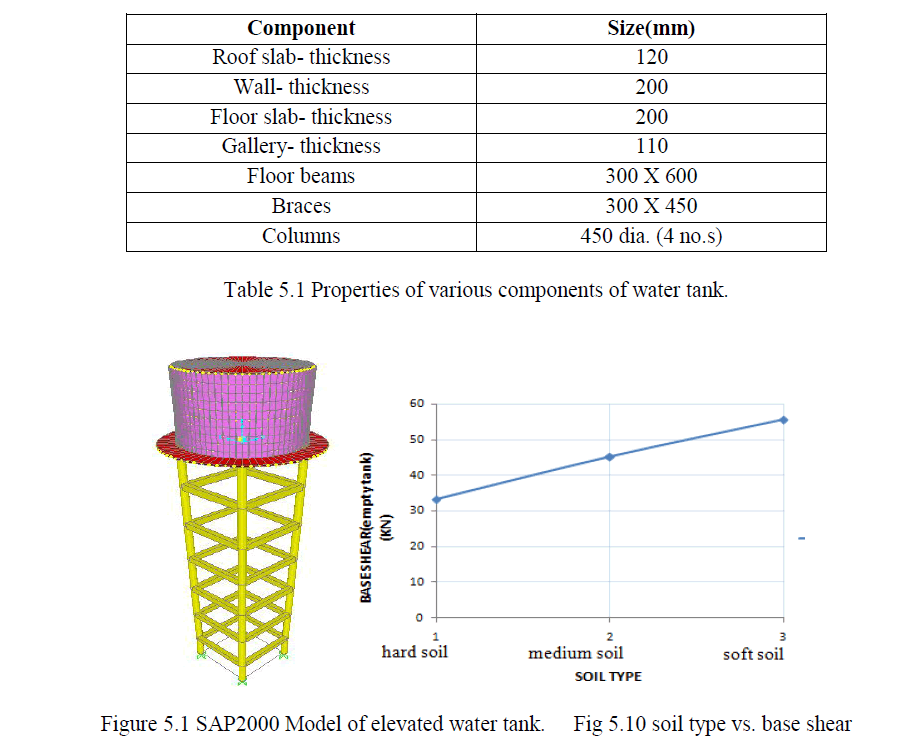 |
| The behaviour of the water tank has been analysed for various parameters like, change in the height of staging, change in the capacity of the tank, seismic intensities, and change in the type of soil etc. Dynamic analysis has been performed on the finite element model of water tank to compute the stiffness and mass of the staging. |
ZONE & HEIGHT OF THE STAGING |
| In the previous sections we have seen the behaviour of water tank under different zones and for different heights of the staging is seen separately now, both these factors are combined. In this study both the Zone and height of the staging are varied to understand the behaviour of the water tank under different conditions. The cases studied are explained with the help of a flow chart. |
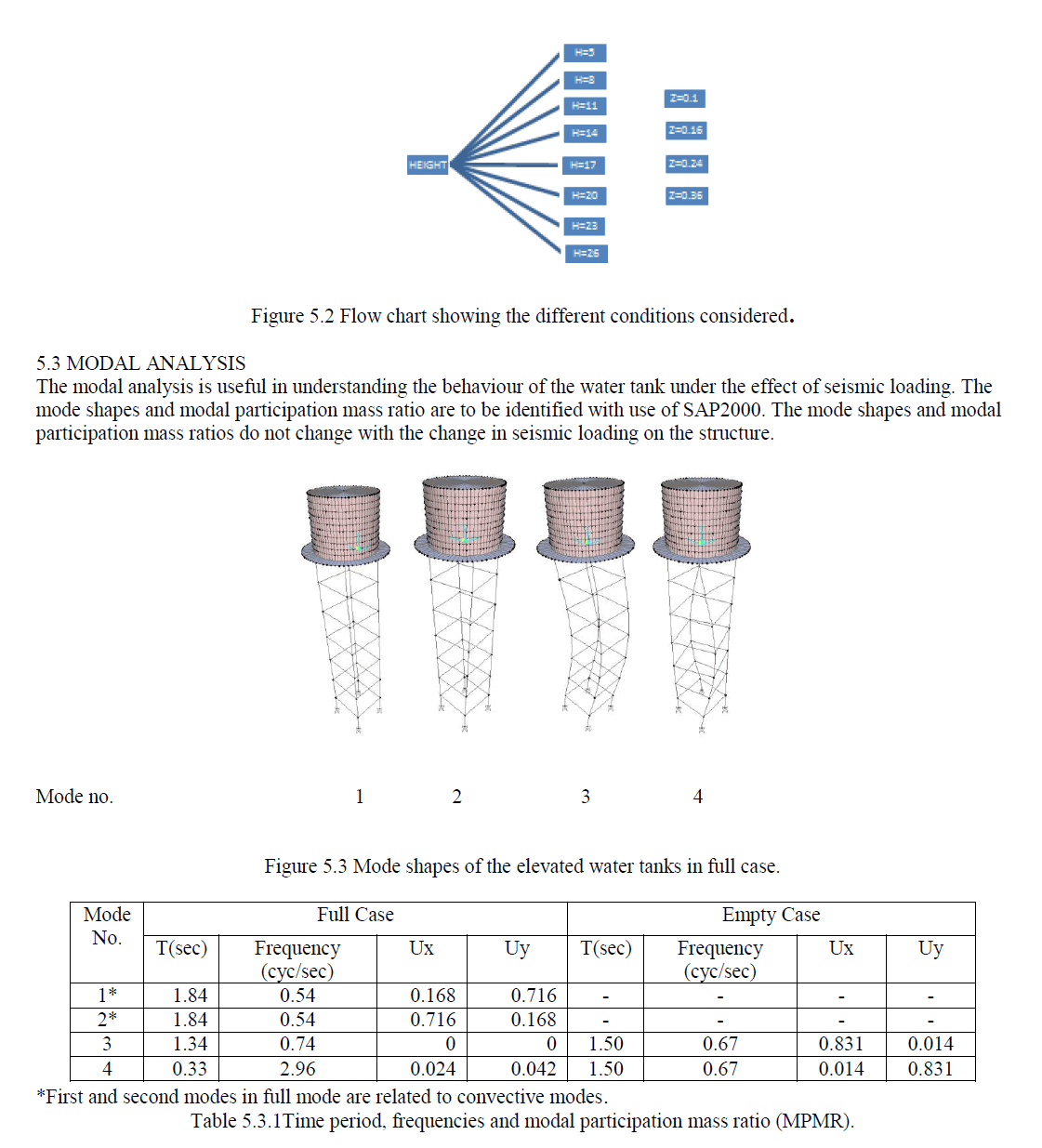 |
| Ux, Uy are the mass participation ratios in X & Y directions, respectively. |
| The pattern of vibration, in quantitative terms, is the mode shape of that structure. From the table we can see that the sum of modal mass participation of the 1st five nodes of Uy is more than 90% hence five node shapes are to be considered. The mode shapes and modal participation mass ratios depends on the mass and stiffness of the structure and they do not change with change in seismic intensity and type of soil, hence from these mode shapes and modal participation mass ratio the response of the water tank under seismic loads can be better understood. |
CONCLUSIONS AND SCOPE OF THE FUTURE STUDY |
| Seismic analysis of elevated RC circular water tanks has been performed as per IITK-GSDMA guidelines and behaviour of the water tank for various parameters viz., Zone factor, Soil condition, different staging heights have been analysed. The modal characteristics (mode shapes and the modal participation mass ratio) of the structure were ascertained using SAP2000.The Supporting structures i.e. the staging’s were found vulnerable for seismic forces. Hence, an attempt has been made to study the effect of variations in staging height on the seismic behaviour of elevated water tank. The following observations were found in the analysis as listed below. |
| The following observation has been made, |
| 1. The height of the staging has influence on base shear characteristics. The variations are depicted in Figure 5.15. The base shear increases until a critical staging height and then it start decreasing. Care should be taken in avoiding the critical height. |
| 2. The variation of base shear with respect to seismic intensity factor is found to be linearly varying. |
| 3. G rade of concrete has influence on the stiffness of the staging which effects the base shear of the structure, which is depicted in Figure 5.5. |
| 4. The base shear varies linearly with the change in soil from soft to hard, which is depicted in Figure 5.10. |
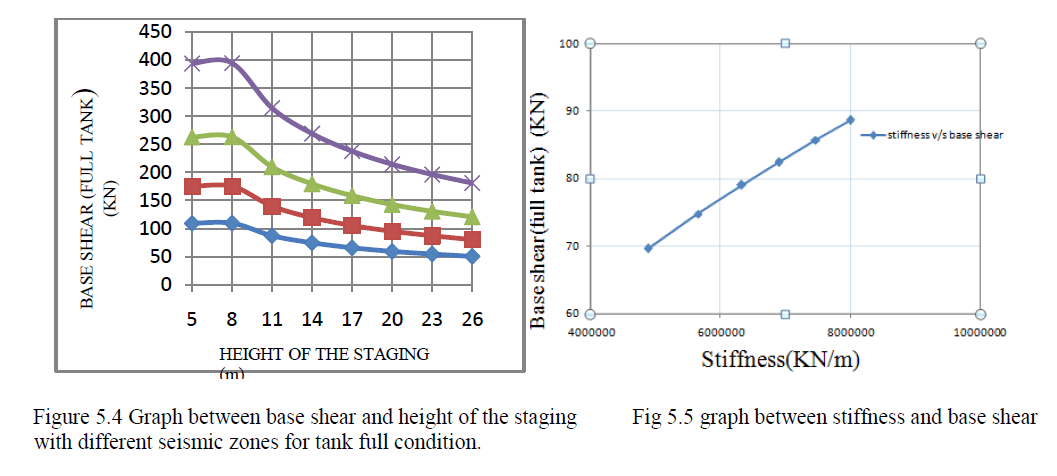 |
SCOPE OF FUTURE STUDY |
| The present study was primarily focussed on analysing the performance of Elevated RC circular tanks having capacity less than 200m3for varying staging heights. In this preliminary investigation it can be observed from section 5.3, that, the elevated water tank appear vulnerable for certain height of staging. Further, Response spectrum analysis has been carried out in view of inadequate Earthquake data. These results have to be quantified with Vulnerability assessment of EWT using artificial earthquake data and experimental investigation. |
References |
|